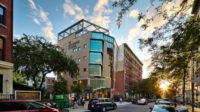Columbia's Harlem Plan Gets Cold Reception
Columbia University’s simmering tension with Harlem residents over its plan to build a new, 17-acre campus in Manhattanville came to a boil last week when a rowdy, standing-room-only crowd of roughly 400 people armed with signs and maracas packed into a hearing on the school’s 197-C development plan, developed by the Renzo Piano Building Workshop and Skidmore Owings & Merrill (SOM). This reaction made yesterday’s rejection of the plan by the local Community Board an inevitability.
Columbia’s 197-C plan, named for a clause in New York City’s charter that requires potential developers to seek zoning approval through a land-use review, intends to open 94,000 square feet of public space—mainly in the form of a park along 12th Avenue—while simultaneously adding 6.8 million square feet of new academic buildings at a site one-quarter mile north of its existing campus.
“It’s quite striking when we really assess the people who speak in favor of it,” says university president Lee Bollinger. “The sense that this is a valuable project for the city, and the community, is widespread.”
But last week’s five-hour hearing, which was frequently interrupted with boos and jeers—even former New York mayor David Dinkins, who spoke on Columbia’s behalf, was shouted down and forced to relinquish his microphone—proved that consensus on 197-C is, for the moment, wishful thinking. Community residents complained that Columbia’s plan is fatally flawed because it proposes large, modern buildings that are out of character with the existing context. They also objected that the plan necessitates the use of eminent domain.
One structure that remains at the center of both concerns is Hudson Moving and Storage, a century-old warehouse that is the only structure within the expansion zone listed on the National Register of Historic Places. Hudson occupies a site that Columbia envisions as a science center spanning several city blocks along Broadway. The new complex would contain nearly 3 million square feet of research space—including a Level 3 biotech research center—in four box-shaped, glass buildings, and a basement complex burrowed as much as seven stories underground.
“From our perspective, it’s an excellent place to build a series of science buildings that share support spaces below,” Marilyn Jordan Taylor, a partner at SOM, says of the Broadway site. Retaining the Hudson building represents “a conflict,” she adds, because the science facility requires deep, hive-like infrastructure underground that will be co-located with a 2,300-space parking garage, two power plants, and a swimming pool. “We would have to torture the building” to accommodate everything, Jordan says.
But Hudson’s owner, Anne Whitman—whose brothers reluctantly sold their own nearby business, Despatch Moving, to Columbia on August 6—feels that the university should be able to find an alternative solution. “Columbia has enough room to integrate into this neighborhood. It should alter its plan and respect the history of Manhattanville.”
Resistance to the university’s plan intensified late Monday evening, when Community Board 9 voted 32 to two—with two abstentions—to oppose 197-C and, instead, to unanimously adopt its own, alternative development plan dubbed 197-A. The board will deliver its formal response to the Department of City Planning on August 27. From there, the plans will move on to the Borough President’s office, which will hold a public hearing on September 19.
Columbia officials remain undaunted in the face of such opposition—and the possibility of more maracas-filled public hearings. “This plan has enormous potential benefits for the people who live around here, and for the city,” Bollinger says.

